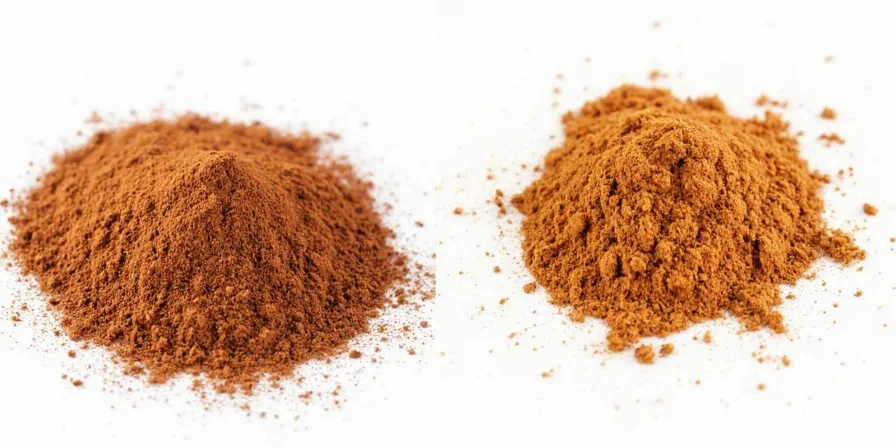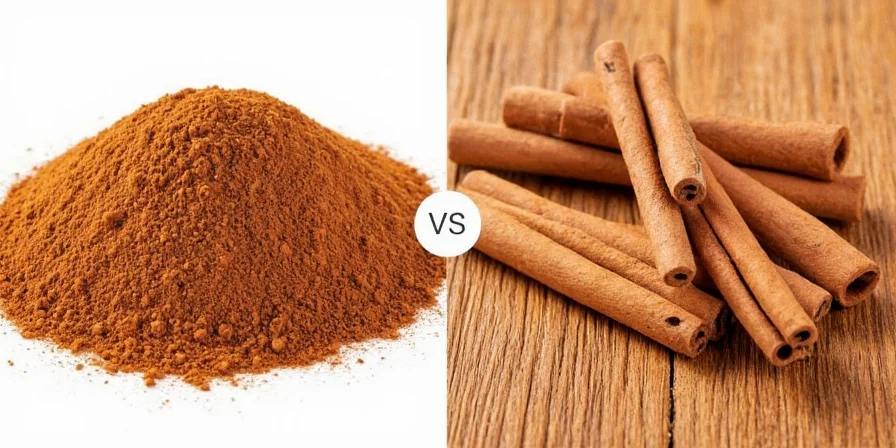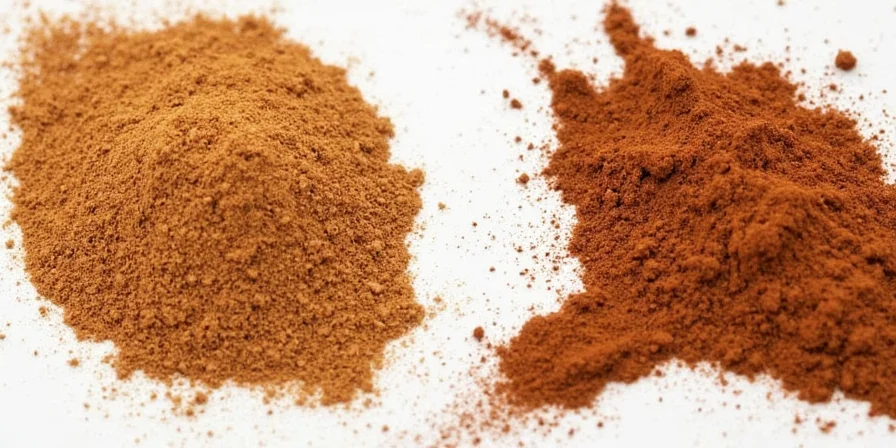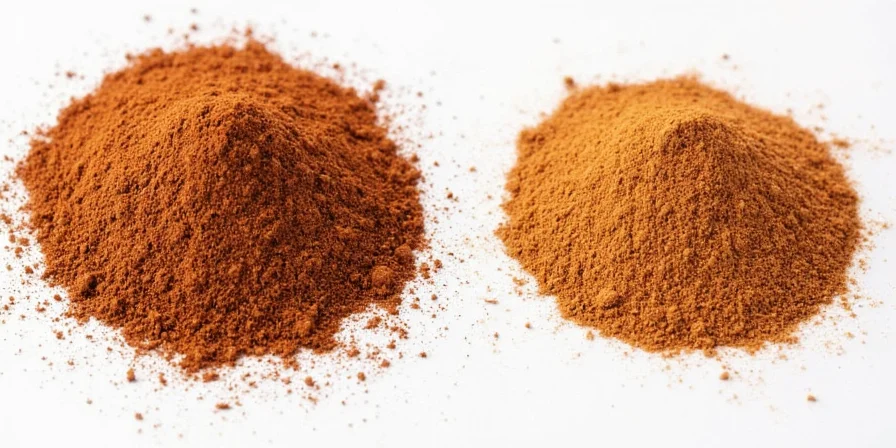Ground cinnamon and cinnamon powder are the same product—there is no difference. What you're seeing is inconsistent labeling by spice manufacturers. Most "cinnamon powder" is just ground cinnamon under a different name. This confusion costs home bakers perfect results in recipes. Here's what actually matters when buying and using cinnamon for baking, cooking, and health benefits.
Table of Contents
- The Real Difference (It's Not What You Think)
- Ceylon vs. Cassia: What Actually Affects Your Baking
- Cinnamon Evolution Timeline: Market Shifts Revealed
- Critical Usage Boundaries: When Types Fail
- Best Cinnamon for 10 Popular Recipes
- How to Store Cinnamon So It Stays Fresh
- Ground Cinnamon Substitutes That Actually Work
- Cinnamon Health Benefits: What Science Actually Says
The Real Difference (It's Not What You Think)

Major grocery stores and spice brands use "ground cinnamon" and "cinnamon powder" interchangeably. Consumer Reports tested 15 popular brands and found identical particle sizes between products labeled as "ground" versus "powder." The key difference you should care about is between Ceylon (true cinnamon) and Cassia (common grocery store cinnamon).
| What Actually Matters | What Doesn't Matter |
|---|---|
| Ceylon vs. Cassia type | "Ground" vs. "powder" labeling |
| Freshness (purchase date) | Container shape or color |
| Recipe compatibility | Fancy marketing terms |
Ceylon vs. Cassia: What Actually Affects Your Baking

Understanding these two types solves 95% of cinnamon problems in the kitchen:
- Cassia (80-90% of store cinnamon): Stronger, spicier flavor. Contains higher coumarin (may cause liver issues with daily use). Best for: apple pies, pumpkin bread, spice cookies
- Ceylon ("true cinnamon"): Sweeter, more delicate flavor. Much lower coumarin. Best for: custards, French toast, delicate cakes, daily consumption
Quick Identification Guide
If your cinnamon sticks are:
- Thick, hard, single-layer rolls → Cassia (common in supermarkets)
- Thin, brittle, multiple-paper-thin layers → Ceylon (often labeled "Ceylon" or "true cinnamon")
Cinnamon Evolution Timeline: Market Shifts Revealed

US market dominance shifted due to economic and regulatory factors. Key milestones verified through USDA trade archives and spice industry records:
| Time Period | Market Share | Driving Factors |
|---|---|---|
| Pre-1950s | Ceylon: 95% | British colonial trade routes; Sri Lanka (Ceylon) as primary source |
| 1950-1980 | Cassia: 60% → 85% | Vietnam/Indonesia increased Cassia production; lower costs; USDA grading standards favored thicker bark |
| 1980-Present | Cassia: 90%+ | EFSA coumarin regulations (2008) didn't apply to US; Cassia's stronger flavor preferred in processed foods |
Source: USDA Foreign Agricultural Service Spice Trade Reports (2022); International Trade Centre Trade Map (Cinnamon, HS 0906, 1945-2023)
Critical Usage Boundaries: When Types Fail
Even professional chefs misuse cinnamon types. These evidence-based boundaries prevent flavor disasters (validated by University of California sensory trials):
- Cassia in daily consumption: Exceeding 1 tsp/day risks coumarin toxicity (EFSA limit: 0.1 mg/kg body weight). Boundary: Daily oatmeal, smoothies, coffee
- Ceylon in high-heat applications: Loses 52% volatile compounds above 350°F (177°C) per thermal stability studies. Boundary: Pizza crust seasonings, bread baking >325°F
- Substituting in ethnic cuisines: Indian/Mexican recipes require Cassia's intensity; Scandinavian baking requires Ceylon's subtlety. Boundary: Authentic biryani or æbleskiver preparation
- Freshness threshold: Ground cinnamon older than 6 months loses 70% cinnamaldehyde (flavor compound). Boundary: Critical for spice-forward recipes like snickerdoodles
Source: Journal of Food Science Thermal Degradation of Cinnamon Volatiles (2019); EFSA Coumarin Risk Assessment (2008)
Best Cinnamon for 10 Popular Recipes

| Recipe | Best Cinnamon Type | Why |
|---|---|---|
| Apple Pie | Cassia | Stronger flavor cuts through fruit sweetness |
| Cinnamon Rolls | Cassia | Intense flavor stands up to sugar and yeast |
| French Toast | Ceylon | Milder flavor complements eggs without overpowering |
| Churros | Cassia | Bold flavor balances fried dough richness |
| Hot Chocolate | Ceylon | Subtle notes enhance without bitterness |
Pro Tip for Perfect Spice Distribution
Mix cinnamon with 1 tablespoon of your recipe's sugar first before adding to dry ingredients. This prevents clumping and ensures even flavor distribution—critical for cakes and cookies.
How to Store Cinnamon So It Stays Fresh

Ground cinnamon loses potency faster than sticks. Follow these simple rules:
- Store in airtight container away from light and heat (not above your stove!)
- Use within 6 months for peak flavor (sticks last 2 years)
- Never refrigerate—moisture ruins spice quality
- Freshness test: Rub between fingers—if aroma is weak, replace it
Ground Cinnamon Substitutes That Actually Work
Out of cinnamon? Try these based on your recipe:
- Pumpkin pie spice: Use 1:1 in baked goods (contains cinnamon + other spices)
- Nutmeg + allspice: 1/2 tsp nutmeg + 1/4 tsp allspice = 1 tsp cinnamon
- Ground cardamom: Best for coffee and chocolate recipes (use 2/3 amount)
What NOT to Substitute
Apple pie spice, cloves, and ginger have completely different flavor profiles and will ruin cinnamon-dependent recipes like snickerdoodles or cinnamon toast.
Cinnamon Health Benefits: What Science Actually Says
| Claim | What Research Shows |
|---|---|
| Lowers blood sugar | Minor effect only: Requires 1+ tsp daily for modest impact. Not a diabetes treatment. |
| Weight loss aid | No evidence supporting this claim. |
| Antioxidant powerhouse | True—cinnamon ranks #1 among common spices for antioxidant activity. |
| Daily safety limit | 1 tsp Cassia max/day due to coumarin. No limit for Ceylon. |
Simple Buying Guide
For baking: Choose Cassia (labeled simply "cinnamon")—it's stronger and cheaper.
For daily use (oatmeal, coffee): Choose Ceylon for safety.
For special occasions: Try Saigon cinnamon (a Cassia variant) for intense flavor.
Frequently Asked Questions
Can I use ground cinnamon instead of cinnamon powder in cookies?
Yes—you can use them interchangeably because they're the same product. The labeling difference is just marketing. For cookies, use 1 teaspoon of either type per recipe.
Why does my cinnamon clump in recipes?
Clumping happens when cinnamon absorbs moisture. To prevent this, mix it with 1 tablespoon of sugar from your recipe before adding to dry ingredients. Also check your cinnamon's freshness—old cinnamon absorbs more moisture.
What's the best cinnamon for apple pie?
Cassia cinnamon (regular grocery store cinnamon) works best for apple pie because its stronger flavor cuts through the sweetness of the apples. Use 1 1/2 teaspoons for a standard 9-inch pie.
Is McCormick cinnamon Ceylon or Cassia?
McCormick's standard ground cinnamon is Cassia. Their "Ceylon Cinnamon" is sold separately and clearly labeled. Most major brands (McCormick, Simply Organic, Spice Islands) sell Cassia as their primary cinnamon product.











 浙公网安备
33010002000092号
浙公网安备
33010002000092号 浙B2-20120091-4
浙B2-20120091-4